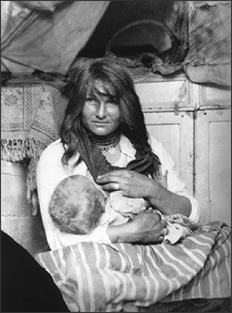




Copyright Warning
All texts/audio/still/motion picture images are strictly copyright to ValleyStream
Media 1980-2017 or to the stated contributor/
copyright holder/s or "unKn". Any unauthorised copying of any images or material
from this website for any use is strictly prohibited without written permission from
the image owners - owners of unknown images ("unKn") from this website please contact
us for fair use or image withdrawal. All rights reserved.

who were to become the Noble Gypsy Tribes we know of today, such as the Woods, Boswells,
Coopers, Lees, Herons, to name a few. It’s feasible the Woods took on their name
from their first encounter with a long spell in a British woodland. Manfri Wood claimed
in his book that the Woods were originally members of the Akbar tribe. In Cymru the
Woods became known as theVeshenge (woodland Gypsies). In England the Boswells were
originally known as the Choomomescro, the Greys - Griengro, Coopers - Turalienge,
Lees - Purum, Lovells – Camomescro, Smiths – Petulengro, Locks - Klizinimangero,
etc. Their British pseudonyms were often lifted from existing families or from occupations.
The Locks were originally Boswells who once fiddled open a farmer’s locked gate.
The Welsh Kaule became fine harpers like the Roberts, fit for Queen Victoria, fiddlers,
flower-sellers, peg- and basket-makers, horse- and scrap-dealers, and the finest
storytellers around.
Gypsies had been recorded in Wales by 1579. Like all Roms across the great Earth
plain, the Walshenenge Kaule were natural shape-shifters who lived by wit and charm,
adapting to new  environments in order to survive. If persecuted but not hung by their
necks, they would jal (go) to another land. You could say Cymru became their remote
haven, a kind of “Kalistan” – in the late 1890s it took the great Bauro Rai John
Sampson 10 years to find Matthew Wood and his fiddle in only a 30-mile radius. These
first Kaule successfully embraced the terrain and roadscapes they roamed, journeying
freely by either foot or mokhiako verdo (donkey and cart) and trading pegknife-ware
or choppin deals with the local vlija
environments in order to survive. If persecuted but not hung by their
necks, they would jal (go) to another land. You could say Cymru became their remote
haven, a kind of “Kalistan” – in the late 1890s it took the great Bauro Rai John
Sampson 10 years to find Matthew Wood and his fiddle in only a 30-mile radius. These
first Kaule successfully embraced the terrain and roadscapes they roamed, journeying
freely by either foot or mokhiako verdo (donkey and cart) and trading pegknife-ware
or choppin deals with the local vlija
Rachael Hearne, © TJ Lewis
Welsh Romani
(village) people.
In South Wales from the mid 1800s routes around the baure gava (big cities and towns)
allowed for larger horse-drawn Romani verde (living caravans) due to better made-up
roads for industry, etc, with a kinder terrain than in the mountainous North. Types
of waggons used were mainly plain affairs of the lighter ledge style, kite waggons,
square bows, peg waggons, bowtops and openlots. Hawker and flat carts would be seen,
and the occasional flashed-up Dunton Reading or Henry Jones ledge roll past – often
owned by a proud graiengero (horse-dealer) boasting plenty of lovo (money). Interestingly,
the brush waggons, which are almost extinct today (bar one), frequented our Welsh
villages and towns, hawking brush and wicker wares, carpets, etc. This waggon was
a Romani supermarket on wheels, its exterior smothered in an array of glass cupboards
and spindled shelves from front to back - displaying all types of merchandise. The
door was always at the rear. The knife grinder’s barrow was also a popular push about
the lanes, with a Rom sharpening knifeware for housewives.
The true Romani verdo must not be confused with the showman caravans with “wheels
under” but instead wearing large rear wheels “outside the body”. Nevertheless, after
the Great War many of the 12 foot straight-sided showman waggons were soon discarded
by the fairground foki as they modernised and moved on to motorised vehicles. These
vans were often taken over for pennies by the struggling Roms. The traditional Romani
verdo was a Romanichal’s most prized procession, and a typical fine van built in
1895 would set a young Rom and his Romni (wife) back a hefty £60 or so, being built
by a local wheelwright / coachbuilder. Roms rarely owned fully tooled out workshops,
let alone were builders of quality wooden-sided verde, instead they knocked up mainly
pegknife waggons, whittled together by penknife and luck, enough to do the job. Unlike
England, Wales had few true verdo or showman caravan coachbuilders. Philips of Newport
built greatly admired showmans, and Henry Jones just over the






 environments in order to survive. If persecuted but not hung by their
necks, they would
environments in order to survive. If persecuted but not hung by their
necks, they would 